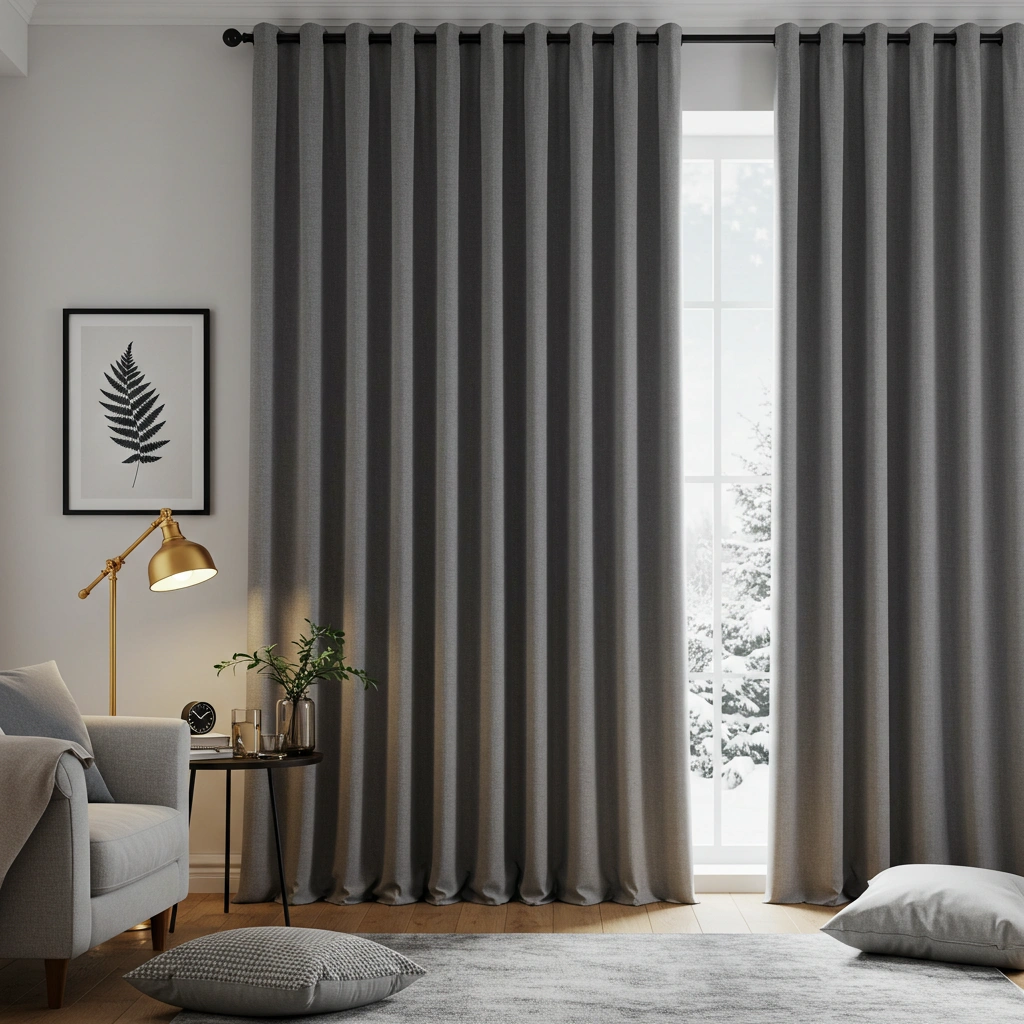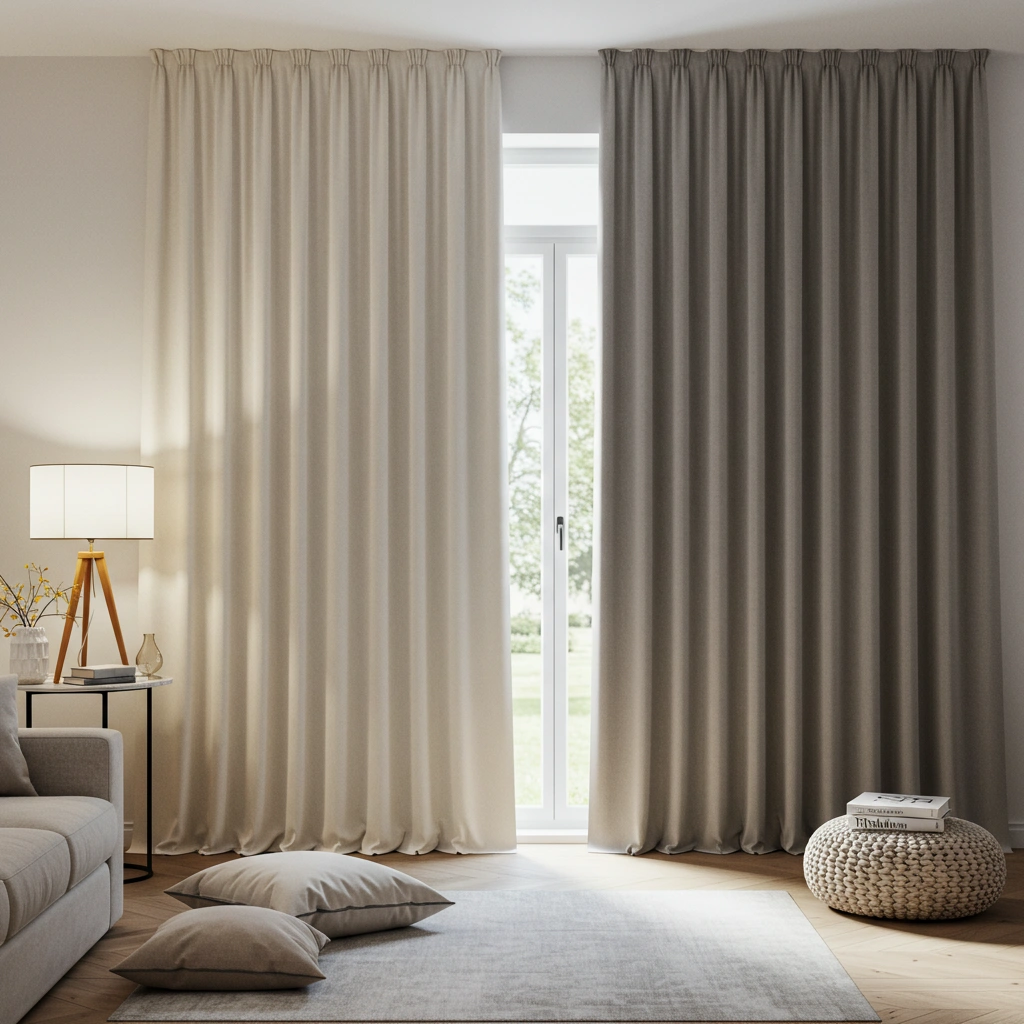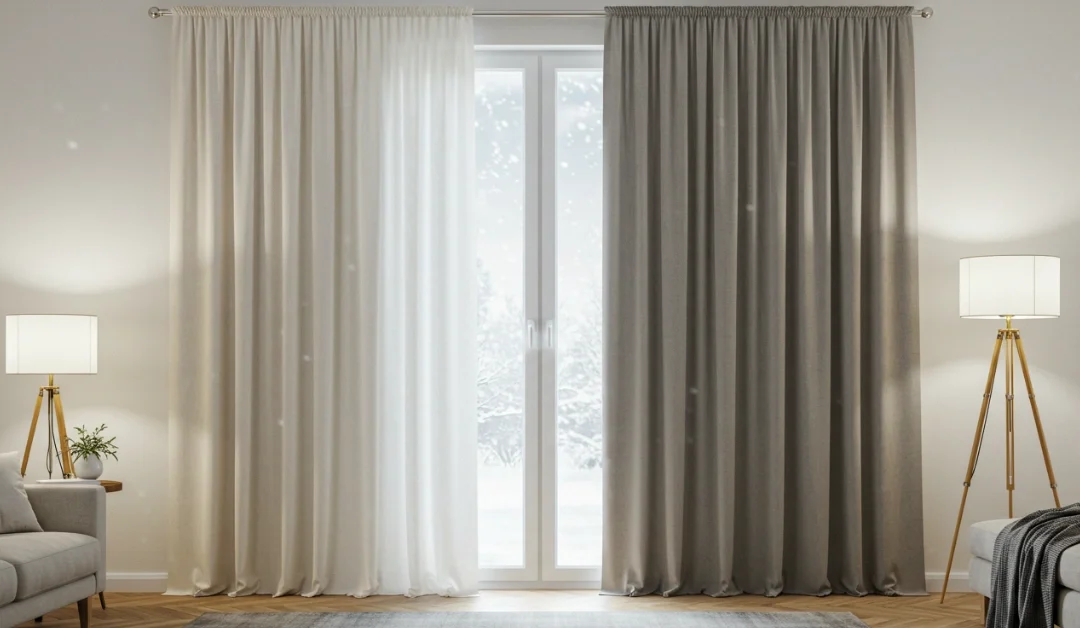Thermal curtains are designed with thick, multi-layered fabrics that are engineered to block heat transfer through windows. Unlike regular curtains, which are often made of lightweight materials like cotton or sheer polyester, thermal curtains are constructed with insulating linings (e.g., foam, aluminum, or blackout fabric) to trap air and reduce energy loss.
For example, a typical thermal curtain might include:
- A decorative outer layer for aesthetics.
- A middle thermal lining (e.g., foam or rubber) to block heat.
- A reflective inner layer (e.g., aluminum-coated fabric) to bounce sunlight.
Regular curtains, while stylish, do little to control indoor temperatures. For more on fabric choices, see Curtain Fabric Style for Every Room.
1. Why Should You Care About Energy Efficiency in the UAE Climate?
The UAE’s extreme climate demands heavy reliance on air conditioning, which accounts for over 60% of household energy use. Thermal curtains can reduce this burden by:
- Blocking 30–45% of heat gain through windows during summer.
- Preventing up to 25% of heat loss in winter, when heating is occasionally needed.
This is critical in cities like Dubai and Abu Dhabi, where temperatures often exceed 45°C. By lowering AC usage, thermal curtains help cut electricity bills and reduce carbon footprints.
2. How Do Thermal Curtains Work?

Thermal curtains operate on two principles: reflectivity and insulation.
- Reflectivity: Aluminum-coated linings reflect sunlight away from windows.
- Insulation: Air trapped between fabric layers acts as a barrier to heat transfer.
In summer, closed curtains reflect sunlight and absorb residual heat. In winter, they trap warm air near windows, reducing drafts.
3. Do Thermal Curtains Help You Save Energy?
Can Thermal Curtains Reduce AC Usage and Electricity Bills?
Yes! Studies by the U.S. Department of Energy suggest that properly installed thermal curtains can reduce cooling costs by up to 20%. In the UAE, where AC use is year-round, this translates to significant savings.
Do They Lower Cooling Costs During Summer?
By blocking solar heat gain, thermal curtains reduce the need for constant AC cycling. Pair them with window films (discussed here: Window Films Are a Smart Choice for Your Home ) for even better results.
Do They Help Keep Rooms Warm in Winter?
Yes! Thermal curtains act as an extra layer of insulation, preventing warm air from escaping through windows. This is especially useful in older homes with single-glazed windows.
Can They Prevent Heat Buildup in Summer?
Absolutely. Closed curtains during peak sunlight hours (11 AM–4 PM) can lower indoor temperatures by 5–10°C, reducing reliance on cooling systems.
4. Are Thermal Curtains Worth the Investment?

Do Thermal Curtains Offer Long-Term Savings?
Over time, yes. While prices range from AED 150–500 per pair, the reduction in electricity bills often offsets the cost within 1–2 years.
Is the Return on Investment Good for UAE Homeowners?
For UAE homes, where energy costs are high, thermal curtains are a smart investment. Pair them with smart blinds (learn more: Smart Blinds for Modern Homes ) for automated energy savings.
5. Should You Choose Thermal Curtains Over Regular Curtains?
Are Thermal Curtains Better at Insulating Windows?
Yes. Regular curtains allow heat and cold to pass through easily, while thermal curtains create a sealed barrier.
Do They Offer Better Light and Temperature Control Than Regular Curtains?
Yes. Thermal curtains block 90% of sunlight in summer and retain heat in winter, unlike sheer or lightweight fabrics.
6. What Features Should You Look for in Energy-Saving Drapes?
- Fabric Type: Thick, tightly woven materials like polyester or velvet.
- UV Protection: Coatings that block 99% of UV rays to protect furniture and floors.
- Noise Reduction: Dense fabrics can reduce outside noise by up to 50%.
- Easy to Clean: Machine-washable linings that retain thermal properties.
For more information on durability, see Best Wardrobe Materials.
7. Which Thermal Curtains Work Best for Homes in the UAE?
- Blackout Curtains: Ideal for bedrooms and media rooms.
- Aluminum-Lined Curtains: Best for extreme heat.
- Eco-Friendly Options: Curtains made from recycled materials (learn more: Eco-Friendly Carpets ).
To purchase in the UAE, visit local retailers such as Carrefour or Home Centre, or explore online platforms like Amazon UAE.
8. How Should You Install Thermal Curtains for Maximum Efficiency?
- Fit Well: Curtains should extend 6–8 inches beyond the window frame to seal gaps.
- Use Thermal Rods: These help press curtains against the wall, minimizing air leaks.
- Seal Gaps: Apply adhesive-backed draft stoppers or caulking around windows.
For installation tips, see Installing and Maintaining Your Curtains.
9. How Do You Maintain Thermal Curtains to Keep Them Working Well?
- Cleaning: Machine-wash on a gentle cycle (avoid bleach or high heat).
- Replace When Needed: If linings tear or fade, efficiency drops.
10. Should You Invest in Thermal Curtains for Your Home?
Are Thermal Curtains a Smart Choice for UAE Homes?
Yes. They align with UAE sustainability goals and reduce reliance on energy-intensive cooling systems.
Do the Benefits Outweigh the Costs?
Over time, yes. Pair them with DIY window tinting (learn how: DIY or Hire a Pro Window Tinting Guide ) for maximum savings.
11. Frequently Asked Questions (FAQs)
Yes. They reduce AC and heater usage by blocking heat transfer.
Yes. Thick fabrics absorb sound waves from outside.
Mid-range prices are common (AED 200–400 per pair).
In winter, they trap warm air. In summer, they reflect sunlight.
Some do (e.g., blackout curtains), but others allow dimmed light.
5–10 years with proper care.
Most are, but follow care labels to avoid damaging linings.
Yes. Custom sizes are available for odd-shaped windows.
Yes. By lowering AC/heater use, bills can drop by 15–25%.
Yes. Options include blackout, eco-friendly, and aluminum-lined curtains.

